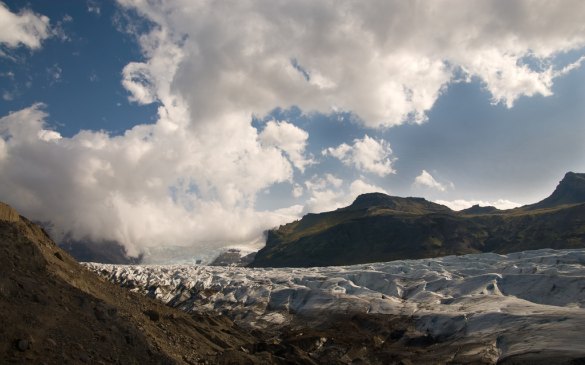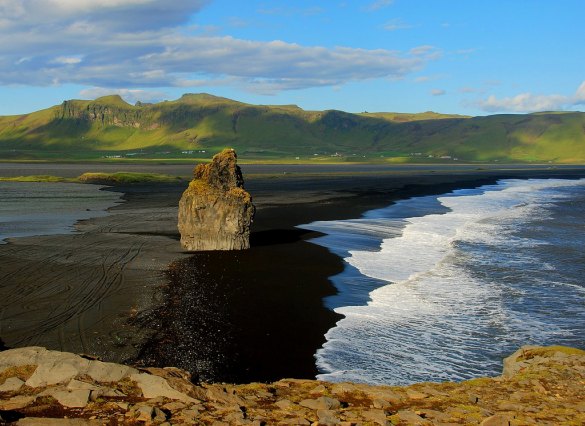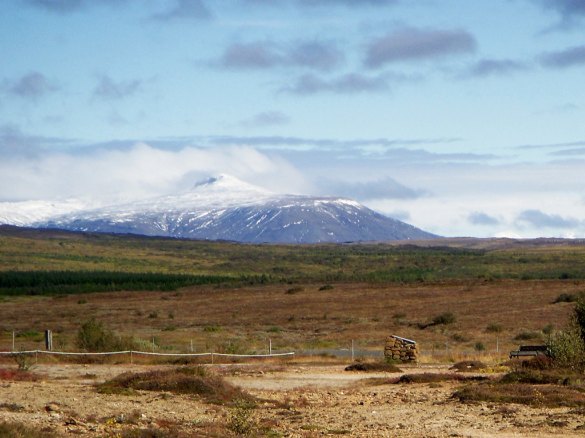Iceland is roughly the size of Ohio, but for a small country, it packs a really big punch. Waterfalls thunder over cliffs, glaciers cover the land in ice, lava creates endless caves and black sand beaches, volcanoes threaten to erupt, geysers shoot water into the sky, earthquakes happen every day, and in the middle of the country, the earth is literally being torn apart.
It’s a land full to bursting with natural beauty and stunning landscapes, which, for most people, are the main reason for visiting Iceland. Here are some of Iceland’s most unique features.
Waterfalls

As glacier water and melting snow accumulate, they create waterfalls all over the country. You can hardly drive for more than an hour without spotting several trickling in the distance. The big ones are impossible to miss.
Gulfoss, one of the country’s most beautiful waterfalls, plunges over 100 feet and can be viewed from above or from the bottom of the canyon, after a steep unpaved descent. It spans quite a distance across, is much wider than it is tall and (while not as large) calls to mind the raw power of Niagara Falls.
Seljalandsfoss drops even farther, with a single plunge of 200 feet over a precipice. While not as wide and powerful-looking as Gulfoss, Seljalandsfoss is special because you can actually walk behind it, standing along the rock walls as the powerful water creates a liquid curtain before your eyes.
Dettifoss, which earns the official title of Europe’s largest waterfall, drops over 150 feet and spans over 300. It’s located in the north of country, near Myvatn.
Glaciers

Glaciers cover a staggering 11% of Iceland’s landscape. The largest, Vatnajökull, covers 8% all on its own. The ice averages 1300 feet thick and covers several volcanoes. It lies in the southeast corner of Iceland’s rugged interior, making it largely inaccessible during winter months.
Other smaller glaciers can be visited year round, but it’s important to go with an experienced guide who will outfit you with the proper gear. They’ll help you strap on crampons and lead you on a hike over the glacier, explaining the unique ecosystems that exist around glaciers, and will keep you safe on the treacherous ice. Some companies will also set up dog-sledding adventures on the glaciers.
The Rift

The American and Eurasian continental plates meet in Iceland and where the plates collide and push off of each other, a rift has formed in the earth. The best place to see it is in Thingvellir National Park, where you can actually walk between the two plates at Almannagjá Canyon.
Impressive from the ground, the rift is even more interesting to see underwater. Several dive companies will outfit you with gear and take you under at Silfra Lake. Divers can actually descend into the crack, while snorkelers in buoyant dry suits can hover over it.
Because of the friction caused by the plates, the park experiences multiple earthquakes each day, one every 3-4 hours. Most are under a magnitude 3 and go unnoticed. The Iceland Meteorological Office tracks the quakes on its website, so you may be surprised to later find out that the very spot you were standing on had experienced an earthquake and you didn’t even feel it.
Northern Lights

Solar activity creates dancing curtains and waves of brightly colored lights in Iceland’s night sky. Called the Aurora Borealis, or Northern Lights, they can be elusive. While many tour companies will arrange excursions to go see them, a sighting is never guaranteed.
The Iceland Meteorological Office tracks activity on their website and rates your chances of seeing them, so if you have a night of good probability, head away from the city and get ready for one of the most memorable shows of your life. On the best nights, you may be able to see the lights from Reykjavik, but they are much more impressive when viewed shining over Iceland’s barren landscape than with the distraction of civilization.
Black Sand Beaches

Two hours south of Reykjavik, the black sand beaches of Vik, which stretch several desolate miles from the Ring Road to the Atlantic Ocean, look like the literal end of the world. They’re formed of volcanic rock and ash, swept by the wind into small hills and valleys, and fringed by sculpted black basalt columns in the sea.
The town of Vik is the wettest place in Iceland, and chances are that if it’s not actually raining, the beach will be covered in fog when you visit. But that only adds to its air of mystery and rugged beauty. You don’t come here to enjoy a relaxing beach day in the sun, but rather to experience the raw power of nature and its impact on the landscape.
Caves

When a volcano erupts, some of the lava spills down its surface while some is pushed out through cracks under the ground. These underground lava rivers have formed an extensive network of caves (over 2000 and counting) in Iceland, which tour guides are happy to help you explore.
Come prepared though, caving in Iceland is serious business and you’ll end up crouching, climbing and scrambling over icy rocks and through narrow tunnels as you check out the unusual rock formations and icy stalagmites caused by glacier water dripping in from above. Some of the more strenuous excursions will also include long stretches of crawling on your belly through tiny openings where just a few decades ago, hot molten lava rushed through, obliterating anything unlucky enough to be caught in its path.
Volcanoes

There are 30-40 active (meaning they have erupted in the last 100 years) volcanoes in Iceland and hundreds more that are dormant. The last destructive eruption was in 1973, when Eldfell on the island of Heimaey erupted and wiped out nearly one third of the town of Vestmannaeyjar.
Hekla, in southern Iceland, is one of the most active volcanoes in the world, with recent eruptions 1991 and 2000. You’ll find several tour operators in Iceland who can transport you to both active and dormant volcanoes and show you the effects that volcanic eruptions have on the local ecosystem.
You’ll see underground lava rivers still flowing, hardened lava and volcanic ash, and former lava field that have now been covered over with spongy moss to form an otherworldly bright green landscape of craggy peaks and crevices.
Horses

Riding horses in Iceland is an unforgettable experience. The landscape you ride over is stunning, but what really makes it so special are the horses themselves. Short, stocky and sturdy, they can carry around three times their weight. While many people mistake them for ponies, these are actual horses who just happen to be smaller, and who have a special fourth gait called the tölt – a fast pace similar to the trot but so smooth you’ll barely feel like you’re moving.
If you don’t want to make arrangements to go riding, just pull over near any field in the countryside and chances are, you’ll soon by making some new friends. Icelandic horses are known for their gentle curiosity and friendliness and with their shaggy winter coats and docile nature, they almost resemble a four-legged teddy bear.
It seems everywhere you turn in Iceland there’s another sight that catches your breath and makes you wonder “how can that be real?” From the explosive spurts of water coming from Stokkur (the geyser near Geysir, the namesake geyser which no longer erupts) to the steaming neon blue waters of the Blue Lagoon (which is man-made though the water is natural), Iceland is place full of wonder and some of the most unforgettable landscapes on Earth.
If you’re planning a trip to Iceland, check out WhyGo Iceland, your one-stop guide for Iceland travel advice, tips, information and inspiration, find out 25 things you didn’t know about Iceland, or read 10 reasons to visit Iceland now.
Photo credits:
Waterfall by cfwee on Flickr, Glaciers by Martin Hapl on Flickr, Rift by Sarcasmette on Flickr, Aurora by Álfheiður ….. on Flickr, Black Sand Beach by Rod the Rabid Rodent on Flickr, Caves by Katie Hammel, Volcanoes by Joe Hatfield on Flickr, Horses by jasperwiet on Flickr